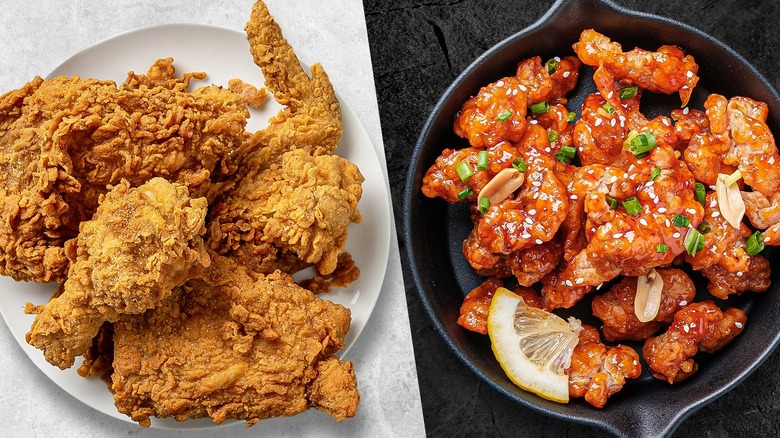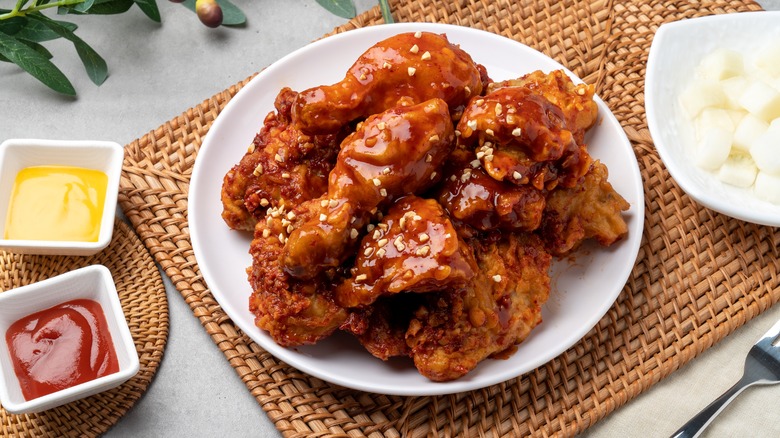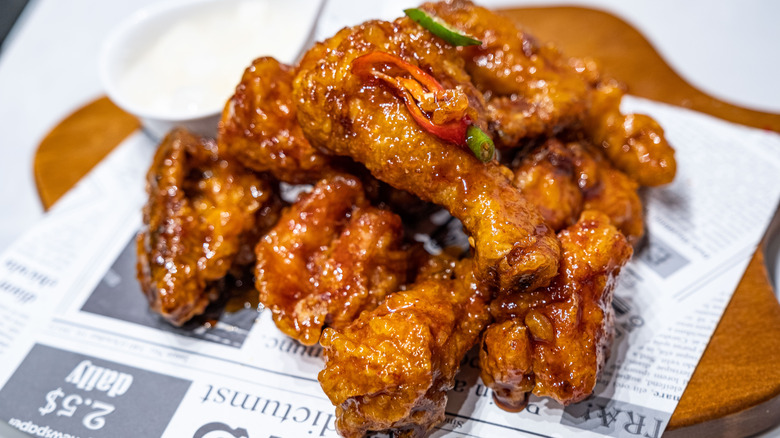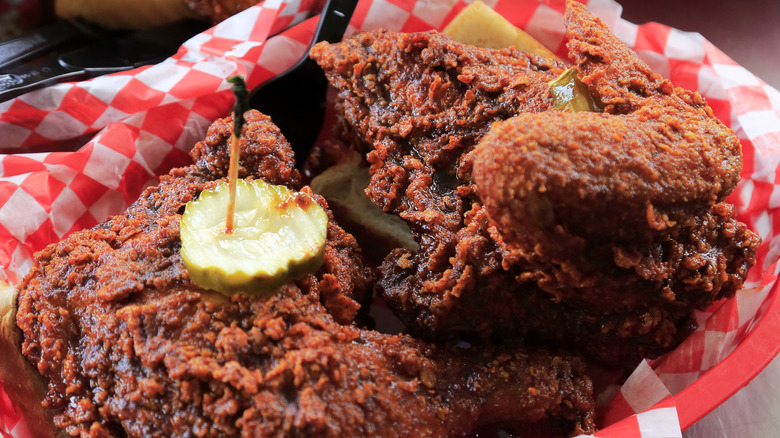US Vs Korean Fried Chicken: The Core Differences
Few foods deliver a comforting appeal quite like fried chicken. Whenever executed well, it showcases the bird in an especially delectable format — tender and juicy interior meat, encased in a delicious crunchy batter. It's no surprise the preparation style is so prevalent, with a multitude of renditions worldwide. In addition to the many American iterations, it's also a popular dish across Asia. Notable examples include delicate Japanese karaage, intensely marinated Thai Gai Tod, and aromatic popcorn-style Taiwanese fried chicken.
Yet, one of the most beloved takes of all is the Korean version, which is becoming one of America's favorite foreign styles. Such an alignment with the palate is more than a coincidence; Korean fried chicken takes significant influence from the U.S. In fact, historians suggest that stationed troops introduced the cooking style during the Korean War. It's proposed the dish's roots took hold all thanks to Black American soldiers, who impressed locals with the dish during holiday cookouts.
The tasty method was noted, and once war shortages improved, it started appearing in restaurant settings. It took until the 1980s for the dish to reach widespread popularity, making it a young addition to the cuisine. However, it's now emerged as a distinct fried chicken style, with a batter, sauce, and consumption ritual that differentiates from its American predecessor.
Korean fried chicken features a thin and crispy double fried batter
One of the primary differences Korean-style fried chicken has from American-style is its external crunch. The meat is dipped in an ultra-thin, typically potato starch-based batter, which is double-fried to attain an extra crispy result. The twice-over cooking lends the dish a specific feel and flavor. The first round is conducted at a low heat, with the principal aim of cooking the chicken's interior. On the subsequent fry, the temperature is raised, encrusting the nuggets with a tasty texture. Potato starch crisps extra well with such a technique, hence why it's used with this recipe.
Alternatively, American fried chicken tends to have a thick batter, composed of heftier ingredients like flour, eggs, and even beer. The pleasantly dense coating has its own appeal — it ideally contrasts the larger chicken pieces common in the U.S. Such a batter is fried to a palatable golden yellow — yet not burnt — state, achieved with hot oil kept at a consistent temperature — one of the crucial tips for a perfect fried chicken.
Both styles may encompass some deviations — some Korean fried chicken joints may opt for a single fry, and there are double-fried American recipes, too. However, the general prevalence of each technique showcases the typical culinary style of each cuisine.
The two fried chicken styles are seasoned differently
There are many ways to upgrade fried chicken, so carefully selecting seasonings and sauces is a crucial part of consumption. U.S.-style fried chicken typically reaches for a vibrant mixture of spices, which are added to the breading, or sometimes diluted in buttermilk. Common flavors include varying ground chilis, flavored salts, garlic, and onion powder. Many Americans love their fried chicken with a dash of spice and heat, which can reach scorching levels in renditions like the Nashville style. However, there are also versions that keep the bird more plain, involving only salt and pepper in the recipe. Sauces are then served on the side, with diners dipping their chicken bites per taste.
Korean chicken's flavor profile begins with the poultry being marinaded. This spice mix is inspired by the American mix, with additions like onion powder, garlic powder, as well as sugar. For the liquid base, many preparations soak the chicken in milk or rice wine.
Korean-style chicken also achieves delicious sweet-and-spicy flavor through an external glaze. Popular candidates include delicious dakgangjeong, which is made with whole chilies, vinegar, sugar, and soy sauce, as well as sweeter yangnyeom, made with different syrups and jams, gochujang, soy, and sugar. Restaurants typically offer a selection of flavors, each crafted in a unique fashion. So, while there's some overlap in the ingredients with both styles, the resultant dish differs.
U.S.-style chicken comes in more variations
Venture to a popular Korean fried chicken chain and you'll find many options on the menu. Typically, these establishments prepare whole chickens, which are split among family and friends. However, you can also find nuggets, drumsticks, and other cuts in individual portions. Every restaurant slightly varies the style, sauce, and marinade, but nevertheless, Korean fried chicken represents a relatively unified umbrella of recipes.
It's a sharp contrast to U.S. fried chicken, which comes in an enormous range of substyles. Just take the subtle difference between chicken tenders and fingers. There's also ultra-moist buttermilk marinated chicken, often flavored with a bouquet of spices. And chicken-fried chicken, which is made into a cutlet and covered in gravy. Finally, the most straightforward flour-dredged option is the dish called country chicken.
Then, there are the more specific regional flavors of fried chicken, such as the spicy, vinegary Buffalo-style chicken wings, now a bar classic. Or the aforementioned spicy Nashville chicken, which is famed for its tear-inducing heat. Asian-inflected orange chicken is a Chinese-American creation similar to the Korean version, and a comforting cheese-covered chicken parmesan presents another fusion, blending Italian and American flavors. Plus, other international styles like Indonesian, Filipino, Thai, and Korean chicken are becoming popular restaurant options in the U.S. These flavors being slowly adopted into the American diet is a testament to the country's astounding culinary diversity.
The two dishes are served in different contexts
In the U.S., fried chicken is a meal enjoyed in many situations, from fast food joints to diners, and as a brunch classic alongside waffles. Its casual nature is a large part of its appeal; it's easy to buy a box to go, or order a portion at a bar or a nice restaurant. Certain regional renditions are served with specific accompaniments, such as Buffalo wings that come with ranch, carrots, and celery, or southern-style chicken which is amplified by sides like collard greens, okra, and biscuits and gravy. Generally, the dish is an approachable protein option, akin to a meatloaf or steak.
Conversely, Korean fried chicken has a more specific mode of enjoyment. It's part of a combo called chimaek, in which the dish is paired with pickled radish, beer, and sometimes soju. Oftentimes, restaurants don't serve any elaborate sides. As a result, it's the perfect convivial activity often enjoyed while dining out late at night, or with a box ordered for a picnic or get-together. Popularized in Korean television and music, it's not only a satisfying combination of flavors but also a wonderful way to enjoy a meal with friends.




